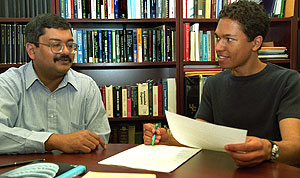Damien Brewer, who will receive undergraduate degrees in chemical engineering and in chemistry in Arts & Sciences today, traces his interest in the environment to a job he held as a high-school student.
As a courtesy clerk at a grocery store in his hometown of Anchorage, Alaska, he found himself developing asthmatic symptoms because of repeated exposure to exhaust from idling vehicles. He was forced to quit the job.

Brewer thought that would take care of the situation, but the symptoms persisted during the winter because of temperature inversions that trap air pollutants in the Anchorage area. He began taking note of such events as Alaska’s seasonal forest fires, which create small-particle pollution.
“I was taken by the fact that the environment impacts people’s health, even in Anchorage, where you wouldn’t think there would be much of a problem,” Brewer says. “I realized that chemistry has a lot to do with how we produce energy and manufacture goods.
“Engineering was a way to combine my interests and tackle a big problem,” adds Brewer, the youngest of four children.
|
School of Engineering & Applied Science College of Arts & Sciences |
Pursuing a career as an architect, Brewer’s father, Raymond, moved his family to Anchorage in the early ’70s. Damien’s mother, Nancy, worked in the administrative office of the Anchorage public schools. His father encouraged him to pursue engineering, and Brewer came to Washington University in 2002, choosing it largely because of the strong environmental program of the chemical engineering department.
Early in his time here, he took a tour of the aerosol laboratory of Pratim Biswas, Ph.D., the Stifel and Quinette Jens Professor of Environmental Engineering Science and director of the Environmental Engineering Science Program, and learned that Biswas was looking for a student worker. Brewer worked most semesters in Biswas’ lab, getting hands-on experience and learning from an esteemed environmental engineer.
This relationship led to a collaboration with Biswas, studying hydrogen production via nanostructured photovoltaic titanium thin-films. Their research was presented at the 2005 annual meeting of the American Institute of Chemical Engineers in Cincinnati.
“Damien was an excellent student,” Biswas says. “I have never had a student who did that well and was the highest scorer in all quizzes, tests and homework.
“He was also eager to work in the laboratory, and despite his busy schedule, he found time to do some neat things in the laboratory examining models for photosplitting of water for hydrogen production.”
Brewer’s undergraduate years are characterized by service, commitment and intellectual curiosity. He tutored inner-city children for two years in the Each One Teach One program; he also organized lessons and taught science concepts for a year at an elementary school in the St. Louis Science Center Outreach Program.
He was a four-year member of the American Institute of Chemical Engineers, serving as an officer for one. He designed and produced student handbooks as an Engineering Orientation Staff volunteer. For three years, he served as an academic mentor in organic chemistry for the University’s Student Educational Services.
During his four years here, he was also very active as a member of the National Society of Black Engineers, each year an officer, the final one serving as treasurer.
“The society has provided a nice community of intellectual African-American colleagues, something I’ve never had before,” Brewer says. “I’ve very much enjoyed the camaraderie and activities, especially going to the annual meeting.”
During the past three summers, Brewer had three different laboratory experiences that have helped mold him as an engineer and shape his vision of environmental engineering. In summer 2003, he was a laboratory technician at Northern Testing Laboratories in Anchorage; in 2004, he was an environmental engineering intern at BP Chemicals in Naperville, Ill., a Chicago suburb.
And in 2005, he worked in the University of Minnesota’s Department of Chemical Engineering, where he synthesized and characterized nanowire arrays for solar-cell applications.
Of the three, he speaks most glowingly of the BP Chemicals internship.
“I had a great mentor, Sanjeev Vora, a native of India, and I lived with him and his family for 14 weeks,” he said. “I got a great background in what the corporate experience is like.”
Through all his experiences inside and outside Washington University, Brewer has come to the understanding that “science and math provide elegant ways of describing nature.”
Drawn to a strong program in photovoltaics and renewable energy, he will go to graduate school at the University of Minnesota and pursue a doctorate.